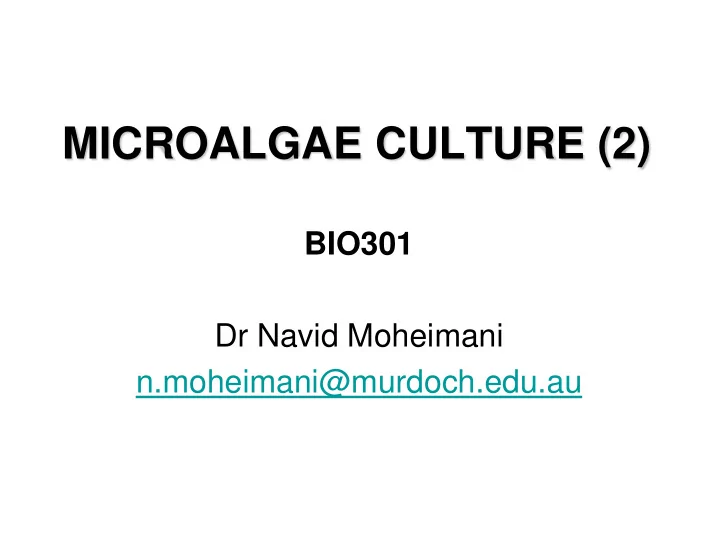

MICROALGAE CULTURE (2) BIO301 Dr Navid Moheimani n.moheimani@murdoch.edu.au
Types of limitation Type I Type II
Limits to Growth Abiotic factors: - Light (quality, quantity) -Temperature - Nutrient - O 2 - CO 2 , and pH - Salinity - Toxic Chemicals Biotic factors: - Pathogens (bacteria, fungi, viruses) - Competition by other algae Operational factors: - Shear produced by mixing - Dilution rate - Depth - Harvest frequency - Addition of bicarbonate
Types of limitation Type I Type II a. Temperature Type I b. Light c. Nutrient Type II d. CO 2 e. Mixing
Limits to Growth • Light (except for heterotrophic culture) • Temperature • Nutrients – N (as nitrate, ammonia, urea) – P – Fe – Si (diatoms) • Supply of inorganic C (CO 2 /HCO 3 - ) • Mixing (turbulence & shear)
Light, Temperature & Oxygen
Fluorescence PSII 6CO 2 + 12H 2 O C 6 H 12 O 6 + 6O 2 6H 2 O + e c e s e h (e)
Light • The Earth receives about 100W.m -2 from the Sun • Irradiance varies with wavelength Solar spectrum as defined in ASTM G-173-03 [1] AM1.5 Solar spectrum in µ mole photons.s -1 .m -2 .nm -1
Light - PAR • Only 431W.m -2 of this is Photosynthetically Active Radiation (PAR) PAR portion of solar spectrum (in terms of µ mole photons)
Algae Are plant like organisms • • All algae contain Chlorophyll a, • Have oxygenic photosynthesis • Have no specialised organelles • Range from uni-cellular microalgae (<1µm) to multicellular macroalgae (up to 60m) • Moist environments (marine, freshwater, soils, salt lakes) • Light (quality and quantity) is the main limiting factor • Many other factors also limit the growth • Low CO 2 • High O 2 • pH • Nutrients • Photosynthetic pigments are – responsible for absorbing light Absorption spectra for different pigments
Algae • If an alga such as Botryococcus with Chlorophylls a and b and β - carotene , is used it is a reasonable approximation that only 160W.m -2 is required for this process • The remainder is not fully utilised.
What we propose:
PV/Filter Electricity Use for Algae pond plant operation
Photosynthetic and respiratory rates of Botryococcus braunii
Effect of pond depth on P. carterae productivity:
Productivity changes over the year DW Lipid CaCO 3 Pleurochrysis carterae productivity – Perth, WA
Irradiance is critical for maximum productivity
Peak Growth rates of two strains of Chlorella pyrenoidosa at different temperatures. Strain 7-11-05 (O) and (x) Emerson strain at high light
Peak Growth rates of two strains of Chlorella pyrenoidosa at different temperatures. ( ,O) Strain 7-11-05 at high (O) and low ( ) light
Growth rate of Dunaliella viridis over a range of NaCl concentrations at three different temperatures. ( ) 30°C; (O ) 26°C; ( ) 14°C
Temperature Oxygen Irradiance
Light, temperature and O 2 on photosynthesis of Pleurochrysis carterae grown in (b) indoors under a controlled condition and at 25 o C. White bars = low O 2 and Grey bars = high O 2
Productivity (g.L -1 .d -1 ) Specific Growth Cultivation n rate period (d -1 ) Dry weight Lipid CaCO 3 Un-heated 14 b pond 02/Jun/2003-01/Jul/2003 0.083 0.0197 0.006 0.0019 02/Aug/2003-28/Sep/2003 18 0.312 0.057 0.018 0.0056 Heated pond a 20 b 02/Jun/2003-08/Jul/2003 0.099 0.025 0.008 0.0025 02/Aug/2003-28/Sep/2003 19 0.315 0.063 0.021 0.0062 Lipid productivity increased by 15%
Gross photosynthesis (µmoles O 2 .µg Chl a -1 .min -1 ) 200 1200 µmol photons.m -2 .sec -1 180 (a) 20 o C 160 ■ 23 o C 140 26 o C 120 100 80 60 40 20 0 Gross photosynthesis (µmoles O 2 .µg Chl a -1 .min -1 ) 200 2500 µmol photons.m -2 .sec -1 180 (b) 160 140 120 100 80 60 40 Skeletonema costatum 20 0 0 20 40 60 80 100 120 140 160 Oxygen concentration (% air saturation)
Gross photosynthesis (µmoles O 2 .µg Chl a -1 .min -1 ) 400 1200 µmol photons.m -2 .sec -1 20 o C (a) 350 ■ 23 o C 300 250 26 o C 200 150 100 50 0 Gross photosynthesis (µmoles O 2 .µg Chl a -1 .min -1 ) 400 2500 µmol photons.m -2 .sec -1 (b) 350 300 250 200 150 100 Tetraselmis chuii 50 0 20 40 60 80 100 120 140 160 Oxygen concentration (% air saturation)
Mixing & Turbulence
Growth of P. carterae in Biocoil in the Airlift design II ( ● ), design III ( ○ ) and design IV ( ■ ), data are mean and range in design IV
Growth curve ( —●— ) and growth rate ( ▼ ) of P. carterae grown under different stirring speed conditions in a carboy type reactor
Nutrients
Effect of temperature and vitamins Pavlova lutheri Chaetoceros gracilis -
What is the optimum pH and how much CO 2 is required ? Productivity µ Lipid (d -1 ) (mg.L -1 .d -1 ) pH content Biomass Lipid 0.21 ± 0.08 144 ± 11.1 32 ± 10.0 Tetraselmis suecica Unregulated 22% 0.24 ± 0.07 193 ± 10.3 44 ± 11.1 8 23% 0.25 ± 0.09 320 ± 32.2 92 ± 13.2 7.5 29% 0.23 ± 0.02 246 ± 21.2 60 ± 12.0 7 24% 6.5 0.21 ± 0.05 142 ± 41.5 30 ± 21.3 21% 0.29 ± 0.04 190 ± 17.9 39 ± 7.2 Chlorella sp. Unregulated 20% 0.30 ± 0.03 203 ± 12.2 44 ± 18.2 8 22% 0.31 ± 0.04 222 ± 14.3 61 ± 11.0 7.5 28% 0.40 ± 0.04 407 ± 05.5 99 ± 16.7 7 24% 0.22 ± 0.06 146 ± 17.9 25 ± 6.6 6.5 17% 0.17 ± 0.09 120 ± 17.9 22 ± 7.2 6 18% 0.09 ± 0.07 90 ± 17.9 18 ± 7.2 5.5 20% 0.98 ± 0.01 310 ± 2.3 61 ± 0.2 Emiliania huxleyi Unregulated 20% 0.76 ± 0.00 230 ± 1.6 59 ± 0.1 7.8 25%
Recommend
More recommend